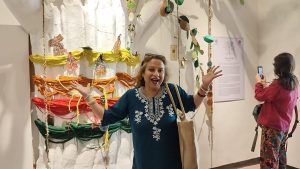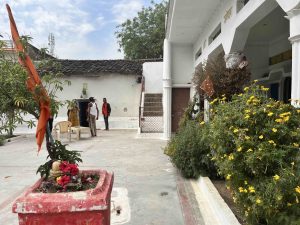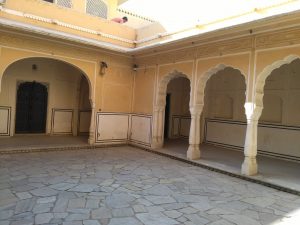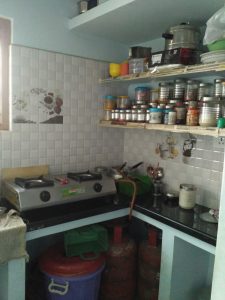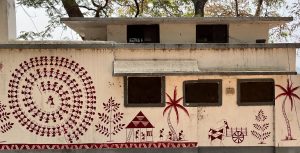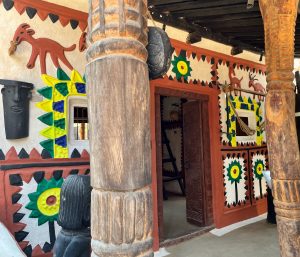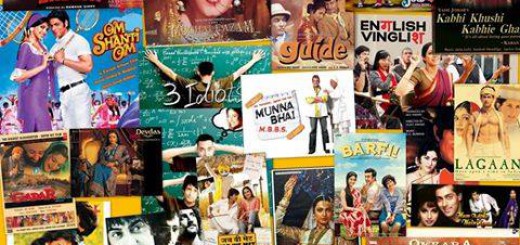मेरा घर
Warm up-
मेरा घर
यह घर मेरा था
यहीं मैं पढ़ा करती थी।
यहीं मेरी माँ सोया करती थीं।
यही वह जगह थी,
जहाँ हम सब मिलकर टीवी देखा करते थे।
भाई से झगड़ती थी,
बहन से बातें करती थी।
बरसों बाद अपने घर नहीं,
अब किसी और के घर के सामने
खड़ी एक लड़की बोली
कुछ कच्ची-पक्की
यादों में खोई।
Lesson Plan
Unit: Theme : घर Lesson Number ____1___ of 1 ______
Time: 75 mins_______________ Age and Proficiency Level:_18-22 (Intermediate (Mid)
Stage 1. Objectives: What will students know and be able to do at the end of this lesson?
KNOW: By the end of the lesson, students will be able to:
- Describe the layout of a house using appropriate vocabulary, including the purpose of each room, using more complex sentences.
- Ask and answer detailed questions about the structure of homes, including the design, colors, and unique features of each room.
- Use complex sentence structures such as relative clauses (e.g., जो कमरे में – the room where, जहाँ पर – where) to describe different parts of the house.
- Discuss the cultural significance of certain items in the home (e.g., paintings, traditional furniture) and link them to the region or lifestyle in India.
- Use comparative and superlative forms correctly (e.g., सबसे अच्छा, इससे बड़ा).
Language Focus:
- Interrogative Pronouns: कहाँ, क्या, कैसा, किसके पास, क्या चीज़
- Complex sentence structures: relative clauses (e.g., जो कमरे में, जहाँ पर), comparative and superlative forms.
- Postpositions: के सामने, के ऊपर, के पीछे, के अंदर, वाला (e.g., सामनेवाला, उपरवाला).
- Vocabulary: detailed names of rooms and cultural items (e.g., बैठक कक्ष – living room, संग्रहालय – gallery, पारंपरिक सामान – traditional items).
Stage 2. Performance Assessment: How will you know that students can do that and in which communication mode?
- Activity 1: Learners will describe their homes in more detail, focusing on the layout, the use of each room, and specific cultural features. They will present this description to a partner using the target vocabulary and sentence structures.
- Activity 2: Learners will write a detailed description of an ideal house, using comparative and superlative forms of adjectives to describe different aspects (size, rooms, design, etc.).
- Activity 3: Learners will match cultural items with specific rooms and provide reasons for why certain items are found in particular rooms, making connections between Indian culture and the home.
Stage 3: Learning Scenarios: What instructional activities will be used? (Use as many as necessary to achieve your learning targets.)
Opening/Activity 1:
Activity 1: Warm-up and House Description (15 minutes)
- Action: Show detailed images of houses from different regions of India (e.g., traditional Rajasthani house, urban apartment in Mumbai, rural house in Punjab). Have students describe what they see using intermediate-level sentence structures.
- Objective: Encourage students to use descriptive language for rooms, architecture, and the cultural context of each house.
- Activity:
- Teacher’s Instructions:
- “यह घर किस प्रकार का है? किस प्रकार के कमरे हैं?” (What type of house is this? What kind of rooms are there?)
- “यह घर बहुत बड़ा है, यहाँ पर बहुत सारे कमरे हैं।” (This house is very big, there are many rooms here.)
- Students use the sentence frames to describe the house in detail.
- Follow-up Task: Ask students to describe their own homes using intermediate sentence structures (e.g., मेरे घर में तीन कमरे हैं, जिसमें एक बेडरूम, एक रसोई और एक बैठक कक्ष है – My house has three rooms, which include a bedroom, a kitchen, and a living room).
Activity 2:
Room Description and Cultural Context (20 minutes)
- Action: Display a floor plan of a house or images of rooms. Discuss each room’s purpose and decor, focusing on the cultural items found in each room (e.g., traditional paintings in the living room, spiritual items in the pooja room, handcrafted furniture in the bedroom).
- Objective: Practice using relative clauses and postpositions to describe rooms and their items.
- Activity:
- Teacher’s Instructions: https://youtu.be/o7OeSJiX3Rw
- “यह रसोई में क्या है?” (What is in this kitchen?)
- “यह जो चित्र है, यह बैठक कक्ष के अंदर है।” (This painting, which is traditional, is in the living room.)
- Students work in pairs and describe a room and its features in the house using the vocabulary.
- Example: “यह कमरे के अंदर बहुत सारे पेंटिंग्स हैं।” (There are many paintings inside this room.)
- Students also connect cultural significance to the items found in different rooms (e.g., यह हाथी का आंकड़ा पूजा कक्ष में है, क्योंकि यह शुभ माना जाता है – This elephant statue is in the prayer room because it is considered auspicious).
- Pair Activity: Students ask each other about the rooms in their homes and answer with more complex descriptions.
Activity 3:
Role Play – Property Agent (20 minutes)
- Action: Students work in pairs. One student is a property agent, and the other is a potential buyer. The agent needs to describe the house they are selling, focusing on the layout, the rooms, and their features (size, decoration, etc.).
- Objective: Practice using comparative and superlative forms, relative clauses, and more complex sentence structures in a real-world context.
- Activity:
- Agent’s Task:
- “यह घर बहुत बड़ा है, इसमें पाँच कमरे हैं, और यहाँ पर एक सुंदर बगीचा भी है।” (This house is very big, it has five rooms, and there is a beautiful garden here.)
- “क्या आप यह घर पसंद करेंगे?” (Would you like this house?)
- Buyer’s Task:
- “क्या यह घर शांत जगह पर है?” (Is this house in a quiet area?)
- “यह जो बैठक कक्ष है, क्या इसमें सोफा है?” (This living room, does it have a sofa?)
- Follow-up Task: Students switch roles and repeat the task.
Activity 4:
Cultural Item and Room Match (15 minutes)
- Action: Show images of cultural items that are commonly found in Indian homes (e.g., carpets, brass lamps, paintings, spiritual statues).
- Objective: Students will match each item with the appropriate room and explain why it might be placed there.
- Activity:
- Students will work in pairs to ask each other where they think certain items should be placed in the house and why.
- Example Question: “क्या आप जानते हैं कि यह हंस का मूर्ति कहाँ पर रखा जाता है?” (Do you know where this swan statue is placed?)
- After the discussion, the teacher will provide the correct answers and ask students to write a short description of one cultural item and the room it belongs in.
Closing/Activity 5:
Exit Slip (5 minutes):
- Task: Learners will write a short description of their favorite room in their house using at least three of the structures they practiced today (comparative/superlative, relative clauses, and postpositions).
- Example Prompt: “मेरे घर का सबसे पसंदीदा कमरा … है क्योंकि … ” (My favorite room in the house is … because …)
Homework:
- Task: Write a detailed description of an ideal house. Use comparative and superlative forms, along with the vocabulary learned in class. Students should include at least three rooms, their functions, and some cultural elements.
Follow-Up Performance Task:
- Scenario 1: Prepare a detailed presentation (oral or written) about a famous Indian house or palace (e.g. Jaipur Havelis). Focus on the architectural features, rooms, and cultural significance.
- Scenario 2: You are an interior designer. Create a floor plan of an ideal house and present it to your class, explaining the layout, rooms, and cultural significance of the items in each room.
Materials needed for this lesson:
- Videos of homes
- Images of various homes in India (rural, urban, traditional, modern, regional styles – e.g., Jaipur haveli, Kerala home, Mumbai flat)
- Floor plans or blueprints of different houses
- Photos of different rooms (bedroom, kitchen, pooja room, veranda, etc.)
- Images of culturally significant home items (e.g., brass lamp, jharokha, rangoli, charpai, traditional paintings)
- Short video clips showing the interior/exterior of Indian homes (with or without narration)
- Handouts
- Vocabulary list: rooms in the house, furniture, colors, cultural items, postpositions, and useful phrases
- Grammar reference sheet: relative clauses (जो, जहाँ), postpositions (के अंदर, के सामने), comparative/superlative forms
- Sentence frames and question starters for pair/group activities
- Exit slip template: with room for name, favorite room, 3 sentence starters
- Cultural matching sheet: images or names of items + columns for “Room” and “Why it belongs there”
- Student-Created Materials
- Students’ photos of their favorite room (for the next day’s activity)
- Graphic organizers for planning their ideal house
- Performance task worksheets (e.g., role-play script templates for property agent or interior designer activity)
- Technology
- Projector or screen to show video/images to the class
- Speakers for audio clips or video narration
- (Optional) Student devices/tablets if doing digital matching or video presentations
- Classroom Props (if available)
- Small objects or models representing cultural items (e.g., small diya, cushion, sari fabric)
- Furniture flashcards (sofa, bed, table, etc.)


